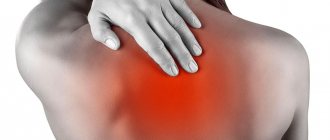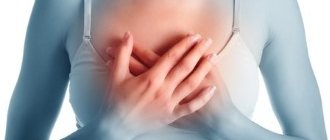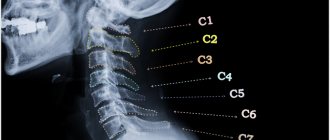12 April 2021
71394
0
2.8 out of 5
Although pain between the shoulder blades is not very common, for those who experience it, this is small consolation. At the same time, discomfort in the area between the shoulder blades can be a sign of a fairly large number of different diseases, some of which can lead to very serious complications and significantly reduce a person’s quality of life. Moreover, if pain in the neck or lower back can be a consequence of banal muscle fatigue after hard physical work, then pain between the shoulder blades due to low mobility of the thoracic spine cannot be of such a harmless nature. Therefore, their appearance should always be regarded as an alarming symptom and immediately contact a vertebrologist, neurologist or spinal surgeon.
Pain between the shoulder blades
One of the most common complaints when visiting a doctor is back pain.
However, it is the pain in the interscapular region that most people often ignore, since it is rarely very strong, due to the lack of mobility of the thoracic spine. The thoracic spine does not have such an increased load as the cervical and lumbar spine. The shoulder blades are flat bones that fit tightly to the ribs of the posterior chest wall, performing a protective function and taking part in the formation of the girdle of the upper limbs. In the space behind the scapula along the intercostal spaces there are vessels and intercostal nerves, strengthened by muscles and ligaments. Most of the muscular frame of the back and the girdle of the upper limbs is attached to the shoulder blades.
You need to know that back pain between the shoulder blades is not a disease, but a symptom of a fairly wide range of pathologies, such as osteochondrosis and other diseases of the spine, diseases of the ligamentous-muscular system, the result of muscle spasm and pinched nerve roots in this area, various diseases of the internal organs: respiratory system, heart, stomach, mediastinal organs.
Therefore, before self-medicating using various ointments for back pain, it is necessary to find out what was the real cause of the pain syndrome. Medicines with analgesic properties are not, in fact, treatment and have only a temporary and rather deceptive effect. Accurate and quick diagnosis will help to avoid the development of severe chronic processes and complications.
Diagnostics
Pain under the right shoulder blade occurs in diseases of various organs and systems, which requires the involvement of several specialists and a careful differential diagnosis. During a physical examination, the doctor will look for skin manifestations, signs of injury, or spinal curvature that may cause tenderness in the subscapular area. The most informative instrumental methods for diagnosis are:
- CT scan of the spine.
In orthopedics and traumatology, standard radiography is also used, but computed tomography provides clearer and more detailed visualization of bone formations. In the photographs, the specialist determines postural disorders, damage to the vertebrae, and signs of ankylosing spondylitis. Neurological complications of osteochondrosis can be detected by MRI of the spine. - Ultrasound of the abdominal cavity.
Given the high prevalence of hepatobiliary disorders, standard diagnosis includes ultrasound examination of this area. On ultrasound, biliary stones, thickening of the gallbladder wall, and inflammatory changes in the liver are clearly visible. To assess the contractile function of the bladder, a test is done with a choleretic breakfast. - ERCP.
Invasive endoscopic examination of the biliary tract is the main method for diagnosing cholelithiasis, cholecystitis, cholangitis and functional disorders. The study is carried out for contrast visualization of the ductal system, finding filling defects and inflammation. - X-ray of the OGK.
Diagnosis of pulmonary diseases is impossible without a standard x-ray in 2 projections. The doctor pays attention to focal infiltrates in the lungs, effusion in the pleural cavity, and symptoms of pneumothorax. It is extremely rare that x-rays confirm dextrocardia - then the pain under the right shoulder blade may be of cardiac origin. - Additional invasive methods
. To detect problems with bile secretion, duodenal intubation is prescribed. For difficult to diagnose pulmonary pathologies, bronchoscopy, pleural puncture, and transthoracic biopsy are recommended. Gastrointestinal diseases with an atypical course require diagnostic laparoscopy.
Instrumental studies are complemented by laboratory methods. In the hemogram, special attention is paid to leukocytosis and increased ESR as nonspecific signs of infection. A biochemical blood test is informative for verifying the syndrome of cytolysis and cholestasis in pathological processes in the liver and gall bladder. An increase in acute phase parameters confirms the presence of active inflammation.
Detection of kidney damage is based on the results of a clinical urine test, a study of concentration function according to Zimnitsky, and a study of cellular composition according to Nechiporenko. If necessary, the diagnostic complex is supplemented with a bacteriological method - culture of sputum, feces, urine or other biological material is carried out on nutrient media.
Physical therapy for back pain
The main causes of back pain between the shoulder blades:
- imbalance of physical activity: when the muscles and ligaments of the back are weakened as a result of their hypotrophy, or, conversely, when there is excessive physical activity with loads that are too heavy for the spine - lifting weights, sharp turns of the body, jumping;
- various spinal injuries;
- osteochondrosis;
- curvature of the spine - kyphosis, kyphoscoliosis, scoliosis;
- spondyloarthrosis;
- pathologies in the thoracic spine, such as protrusions and herniated intervertebral discs;
- humeroscapular periarthritis and periarthrosis;
- intercostal neuralgia;
- myositis;
- IHD, angina pectoris, pre-infarction conditions, myocardial infarction;
- shingles;
- mediastinal pathologies;
- diseases of the respiratory system - pneumonia, pleurisy, pulmonary abscess, bronchiectasis, malignant tumors;
- infectious diseases - tuberculosis, polio;
- pathological processes of the esophagus, stomach, duodenum;
- liver and gallbladder diseases - hepatitis and cholecystitis;
- kidney pathology;
- occupational disease of the spine as a result of harmful working conditions;
- systemic diseases, ankylosing spondylitis;
- tumor metastases in the spine.
Possible nature of pain
It must be taken into account that this criterion does not provide a 100% guarantee of accurate diagnosis, since the pain sensations and pain threshold in people with the same disease will not be the same.
Examples of diseases based on the nature of interscapular pain:
Sharp pain is typical as a response to irritation, inflammation or pinching of the spinal nerve roots. Pain is characteristic of radiculitis, which in turn can be a consequence of pathologies such as osteochondrosis or scoliosis. When swelling and inflammation occur in the area of the pinched root, certain back muscles reflexively tense. Muscle spasm further compresses the root.
With biliary colic, sharp pain also appears in the interscapular region, but in addition – pain in the right hypochondrium. The pain occurs after eating spicy, fatty foods, appearing after a few hours. There is a deterioration in general health with the appearance of nausea and vomiting.
Severe pain is typical:
- with protrusions of intervertebral discs;
- with intercostal neuralgia, the painful sensations have a paroxysmal, encircling character, the pain is localized, as a rule, on one side, and intensifies when tilting to this side and pressing on the affected area;
- with pancreatitis, in addition, the general condition is disturbed, bloating and diarrhea appear;
- With myocardial infarction, there is a significant deterioration in well-being, with arrhythmia, decreased blood pressure, and loss of consciousness.
Burning pain is observed in two conditions - coronary heart disease, angina pectoris and osteochondrosis. Cardiac pathology is characterized by burning, squeezing, pressing pain, which disappears a few minutes after taking nitroglycerin, subsides at rest and does not depend on movements. Pain in the back between the shoulder blades, when the nerve roots are pinched, does not respond to nitroglycerin, and after taking painkillers it calms down, depending on movements and a certain position.
Acute pain may occur:
- with cholecystitis, also appearing with pain in the right hypochondrium, when eating fatty, spicy, fried foods;
- with a stomach ulcer - unbearable pain, radiating to the supraclavicular region or under the left shoulder blade, caused by irritation of the endings of the phrenic nerve, accompanied by abdominal pain. May be accompanied by nausea and vomiting;
- with exacerbation of osteochondrosis, acute pain occurs when moving or lifting heavy objects.
Aching pain is associated with diseases of the spine and bones, such as:
- herniated intervertebral discs.
- kyphoscoliosis - with curvature of the spine, pain between the shoulder blades occurs at points of change in the spinal column as a result of compression of the intervertebral nerves.
- scapular-costal syndrome, which occurs due to inflammation of the synovial bursae of the scapula or as a result of damage to the muscles attached to it, as well as injuries and fractures after prolonged immobilization of the arm. Complaints of aching pain between the shoulder blades, closer to their upper inner corner, accompanied by radiating pain in the shoulder or lateral surface of the chest, complaints of a feeling of heaviness.
- fibromyalgia - damage to extra-articular soft tissues, characterized by diffuse musculoskeletal pain between the shoulder blades, combined with a feeling of morning stiffness;
- spondyloarthrosis - damage to the joints of the spine. In patients with cervical spondyloarthrosis (cervicoarthrosis), pain occurs in the neck, radiating to the shoulder girdle, to the area of the scapula (dorsarthrosis), and the interscapular region. With thoracic spondyloarthrosis, pain rarely reaches a significant degree of severity.
- The same manifestations may occur in some cases with ischemic heart disease and peptic ulcer disease.
Nagging pain in the back between the shoulder blades is characterized by pathologies of the bone and muscle-ligamentous structure:
- osteochondrosis of the cervical spine;
- osteochondrosis of the thoracic spine;
- scapular-costal syndrome;
- myofascial syndrome;
Dull pain occurs with damage to the tendons and ligaments and muscle pathology in almost 90% of cases. The remaining 10% is divided between osteochondrosis and diseases of internal organs - angina pectoris, pneumonia, cholelithiasis, cholecystitis. Pain in the back between the shoulder blades, which does not radiate to other parts of the body, increases with physical activity that involves sore muscles, with pain when palpated, is characteristic of spinal pathology, osteochondrosis.
Stitching pain in the back between the shoulder blades can be a symptom of a disease such as pleurisy, accompanied by cough and weakness. Also, such pain is typical when perforation of an ulcer begins, with the presence of symptoms such as nausea, bloating and abdominal pain, heartburn. Stitching pain in the interscapular area can be:
- with vegetative-vascular dystonia,
- biliary colic,
- pyelonephritis.
Get a free consultation by phone
Nature of pain (what kind of pain it can be)
The nature of the pain that occurs due to problems with pain in the back near the shoulder blades and neck is of great importance. To roughly understand what pain is a symptom of in a particular case, listen to your body and determine the nature of the signals it sends.
Sharp and dull
Acute pain may indicate a developing pathology of internal organs or problems with the spine. Supposed reasons:
- cholecystitis
- most often observed as a response to eating too fatty, spicy or fried foods, in this state the pain radiates to the right hypochondrium; - stomach ulcer - pain syndrome appears only if there is an opening into the pancreas, and not only the area of the shoulder blades, but also the stomach hurts;
- osteochondrosis of the thoracic or cervical spine - such pain usually becomes the body’s “response” to heavy lifting or sudden movement.
If your neck and between your shoulder blades hurt, and the pain is dull in nature, most likely the symptom indicates problems with the musculoskeletal system. The causes of pain may be damage or a pathological process in the ligaments, bones, tendons or muscles. However, such a symptom also does not exclude the possibility of developing diseases of the internal organs.
Sharp and stabbing
Sharp pain, as a rule, occurs if a person has a pinched muscle, an inflammatory process, or a spinal cord nerve root that is compressed. The disease was previously called radiculitis and was a complication of osteochondrosis or scoliosis. Also, if a sharp pain appears between the shoulder blades, it may be evidence of biliary colic, but at the same time there is additional pain under the ribs on the right, nausea and other digestive disorders are observed. If there is pain between the shoulder blades and the neck, this area is tingling, the pain may be a sign of:
- pleurisy – in addition, cough, shortness of breath, weakness will be noted;
- the initial stage of ulcer perforation - bloating, nausea, heartburn, and abdominal pain are also associated;
- biliary colic;
- pyelonephritis
.
To more accurately determine the cause of pain, pay attention to the accompanying symptoms. This will not allow you to make an accurate diagnosis, especially on your own, but the search circle will narrow significantly.
Strong or weak
Severe pain can be caused by disc protrusion between the vertebrae, as well as intercostal neuralgia - in this case, even breathing is very painful. Also, such pain syndrome can be a symptom of pancreatitis - in this case, nausea, diarrhea, vomiting, bloating and other signs of digestive dysfunction are noted. The most serious thing that can be indicated by severe pain in the neck and right shoulder blade is myocardial infarction
. The condition worsens to the point of loss of consciousness, arrhythmia and decreased blood pressure are often noted. Relatively mild pain more often indicates a chronic disease, which constantly reminds itself of itself in this way, as well as pathologies of the musculoskeletal system. If the pain is not severe, this may be the result, for example, of being in a draft, hypothermia, lifting heavy objects, etc.
What signs may accompany pain?
The symptoms accompanying back pain between the shoulder blades will help in diagnosing the real cause of the pain.
The back between the shoulder blades “sears, burns” - this combination of symptoms can be caused by: osteochondrosis of the cervical or thoracic spine; an attack of renal colic; biliary colic; reflux esophagitis.
A feeling of numbness in the back combined with pain between the shoulder blades can be caused by: osteochondrosis; humeroscapular periarthritis; kyphosis and kyphoscoliosis; spondyloarthrosis; coronary heart disease; biliary dyskinesia, peptic ulcer; pleurisy; pneumonia.
Itching of the back and pain in the interscapular area is a rather rare combination of symptoms. The cause of back pain can be biliary colic, as well as herpes zoster.
The back between the shoulder blades feels cold and hurts - a combination of symptoms can be caused by two diseases: pinched spinal nerve root and exacerbation of a disease such as chronic pyelonephritis.
An increase in temperature that accompanies pain between the shoulder blades is typical for pneumonia, pulmonary or bone tuberculosis, hepatitis, cholecystitis, pancreatitis and pyelonephritis.
Cough and back pain between the shoulder blades are symptoms characteristic of diseases of the bronchopulmonary system, such as pneumonia with pleurisy, tracheitis, tuberculosis, lung tumors.
Breathing heavily and your back hurts between your shoulder blades are definitely symptoms of lung damage, a manifestation of pneumonia and pleurisy.
A lump in the throat, combined with back pain between the shoulder blades, indicates that there are pathologies of the esophagus:
- inflammatory diseases,
- tumors
- cirrhosis of the liver with varicose veins of the esophagus.
Belching and back pain between the shoulder blades - this combination of symptoms indicates that the upper gastrointestinal tract is affected. Characteristic of peptic ulcer and cholelithiasis, gastroesophageal reflux.
Nausea and pain between the shoulder blades occur with peptic ulcers, with myocardial infarction, with subdiaphragmatic abscess, as well as with kidney diseases and liver disease.
The symptom of shortness of breath indicates that the condition is life-threatening and the patient urgently needs medical help. The combination of signs of shortness of breath and back pain in the area of the shoulder blades is typical for pneumonia, pericarditis, and pneumothorax. Pain accompanied by shortness of breath, cough and hemoptysis, weakness and fever indicates that an urgent call to the doctor is necessary, rather than thinking about the origin of the pain.
Causes of pain under one of the shoulder blades
When various organs malfunction, they can transmit radiating pain to individual areas of the back. Depending on the right or left side of the discomfort, pain in the spine at the level of the shoulder blades signals specific pathologies. Thus, pain in the back of the subscapular region on the left side may indicate the development of a gastric ulcer. The symptoms of the anomaly are as follows:
- occasional back discomfort on the left side;
- seasonality of exacerbation of symptoms;
- the nature of the pain is increasing;
- at the peak of pain, the urge to vomit appears;
- during attacks of vomiting, noticeable relief occurs;
- the condition worsens every time after eating.
The second most common cause of left-sided attacks of pain in the back is psychosomatics. Each patient's body reacts differently to emotional experiences or acute stressful situations. Against the background of psychological problems, the nervous system experiences temporary disruptions in certain areas, which affects the functioning of all organs. A person feels compression or pressure in the shoulder blade, heat in the chest, radiating sensations to the arm or neck. In this case, the condition is accompanied by fear or panic attacks, up to a feeling of suffocation and a persistent lump in the throat.
Another common cause is a previous myocardial infarction, which leads to intense, everting pain under the left shoulder blade, spreading to adjacent parts (arm, collarbone, sternum, neck). Conventional vasodilators do not have the usual effect. Symptoms most often appear against the background of emotional excitement or excessive physical activity or stress.
Under the right shoulder blade, pain appears as a result of colic occurring in the liver or gall bladder. In this case, accompanying signs are:
- high intensity of pain;
- the whole right side of my back hurts;
- the attack often develops at night or early in the morning;
- at the peak of paresis, gagging appears;
- Radiation extends to the neck, arm, jaw or shoulder.
Inflammatory processes of the respiratory system also provoke acute pain from the subscapular area. In this case, the intensity of the anomaly depends on the depth of breathing. An increase in temperature is often observed. Kidney diseases show similar symptoms. In parallel, urinary disturbances may occur.
What to do for back pain between the shoulder blades?
Emergency treatment of back pain between the shoulder blades is required if it is severe. Excruciating sensations, when the patient is unable to endure them, are rarely caused by interscapular pain. Such pain, caused by irritation of the nerve roots, is characteristic of the lumbar region.
Getting rid of pain caused by muscle spasms on your own is not very difficult. If you feel a feeling of heaviness or tension between your shoulder blades that appears during work, it will be enough to change your position and perform physical exercises. For example, bringing your shoulder blades together and spreading them apart, using circular movements of your shoulders - this exercise will be enough to improve your condition.
Mandatory attributes of the treatment process for any back pain include temporary pain relief using anti-inflammatory non-steroidal drugs for these purposes: ibuprofen, movalis, diclofenac, nimesil. You can use both injections and tablets and preparations in ointment form, as well as combining them to enhance the analgesic effect.
The case when the administration of analgesics reduces the pain, or it goes away completely, indicates that the disease that caused it is relatively compensated. But if the pain persists, it is imperative to undergo the necessary examinations.
The presence of prolonged pain in the interscapular area is a reason to seek help from a doctor!
There are many causes of interscapular back pain, and this can seriously complicate diagnosis.
Most often, the starting point for diagnosis is radiography of the thoracic spine and lungs in projections (direct and lateral). Depending on the data received, the doctor creates a further diagnostic program.
If your back hurts with obvious signs of lung disease, the doctor will definitely prescribe a clinical blood test in order to exclude or confirm inflammatory changes.
If your back hurts and there is a suspicion of an intervertebral hernia or metastases, a CT or MRI of the spine and chest is prescribed.
To make an accurate diagnosis, the doctor often conducts studies that, at first glance, are in no way related to each other. After X-rays and MRIs, the patient may be sent for an electrocardiogram and examination by a cardiologist to rule out heart disease.
When contacting a doctor, it is very important to describe accurate data about the nature of the pain, all accompanying symptoms that accompany the pain from the moment of its onset, as well as factors that provoke increased pain, since the doctor needs help to determine the direction of examinations. Often, unrecognized diseases become the cause of diagnostic errors and inadequate treatment.
Most often, the cause of back pain in this case is muscle spasm in the interscapular area, but doctors must exclude all possible diagnoses, especially in cases where the prescribed treatment does not bring a noticeable result.
Does your shoulder blade hurt?
In our turbulent times, back pain, as well as pain in the shoulder blades and between them, are quite common. Moreover, both among the older generation and among young people. This unbearable discomfort very often still torments office people or people with sedentary work. Such pain can radiate to different parts of the spine. Pain in the area of the shoulder blades is the most common complaint to doctors when dealing with back and spine problems.
Soreness in the shoulder blades is a fairly broad concept, and the doctor needs to understand in which area the pain is localized in order to correctly diagnose the disease. That is why it is customary to distinguish the following varieties:
- Pain under the shoulder blade (left or right);
- Pain between the shoulder blades;
- Pain directly in the shoulder blades.
Why does my back hurt between and under my shoulder blades?
The causes of pain in the shoulder blade area can be all sorts of diseases. Basically, they are associated with the spine. Depending on the location of the pain and the presence of accompanying symptoms, after conducting the necessary tests and examinations, the doctor will determine the cause of the illness tormenting you.
Treatment of back pain between the shoulder blades
To eliminate pain in the interscapular area, complex treatment is used, including drug therapy, physiotherapeutic methods and physical therapy. The course of treatment is selected individually, the most effective combination of methods and the scheme for their use are selected.
If interscapular back pain is caused by osteochondrosis and is vertebrogenic and neurogenic in nature, then physiotherapeutic treatment is an alternative to non-steroidal painkillers.
Physiotherapy methods:
- electrophoresis,
- electroanalgesia,
- magnetotherapy,
- ultrasound therapy,
- barolasertherapy,
- autogravitational traction of the spine,
- paraffin-ozokerite applications
reduce inflammation and pain and at the same time treat the underlying disease that caused back pain between the shoulder blades.
Manual therapy and massage are prescribed only for pain caused by diseases of the spine and nerve roots.
Physical therapy is prescribed only after pain has reduced.
It is recommended that during treatment for back pain, as well as for several days after the end of the treatment process, following a regimen that is as gentle as possible for the spine, excluding physical activity.
In the event that back pain between the shoulder blades occurs for the first time and is very severe, if the pain spreads to the chest, accompanied by any additional symptoms, nothing other than short-term pain relief should be used and you should immediately seek medical help.
Prevention measures
The only and most reliable method of prevention in this case will be an active lifestyle with the absence of bad habits and excess stress. It is necessary to maintain proper physical shape, do gymnastics, learn to move correctly, always monitor your posture, there must be comfortable and correct conditions for work, rest and sleep. If you work for a long time in an uncomfortable position, you need to do warm-up exercises and self-massage more often. Swimming in the pool will perfectly relieve muscle tension.
“Medical Center Yes!” in St. Petersburg, providing a wide range of diagnostic and therapeutic services, specializing in the treatment of neurological and therapeutic diseases. The healing process in our center is carried out taking into account the dynamics of the patient’s condition at different stages of treatment, under the supervision of specialists. Our doctors have developed complex therapy programs aimed at quickly eliminating pain syndromes and the causes of pain. Qualified specialists at our center will help the patient cope with back pain and return to normal life.
Find out about promotions by phone: +7 (812) 323-15-03
All rights reserved by copyright law. No part of the contents of the site may be used, reproduced, transmitted by any electronic, copying or other means without the prior written permission of the copyright owner.








